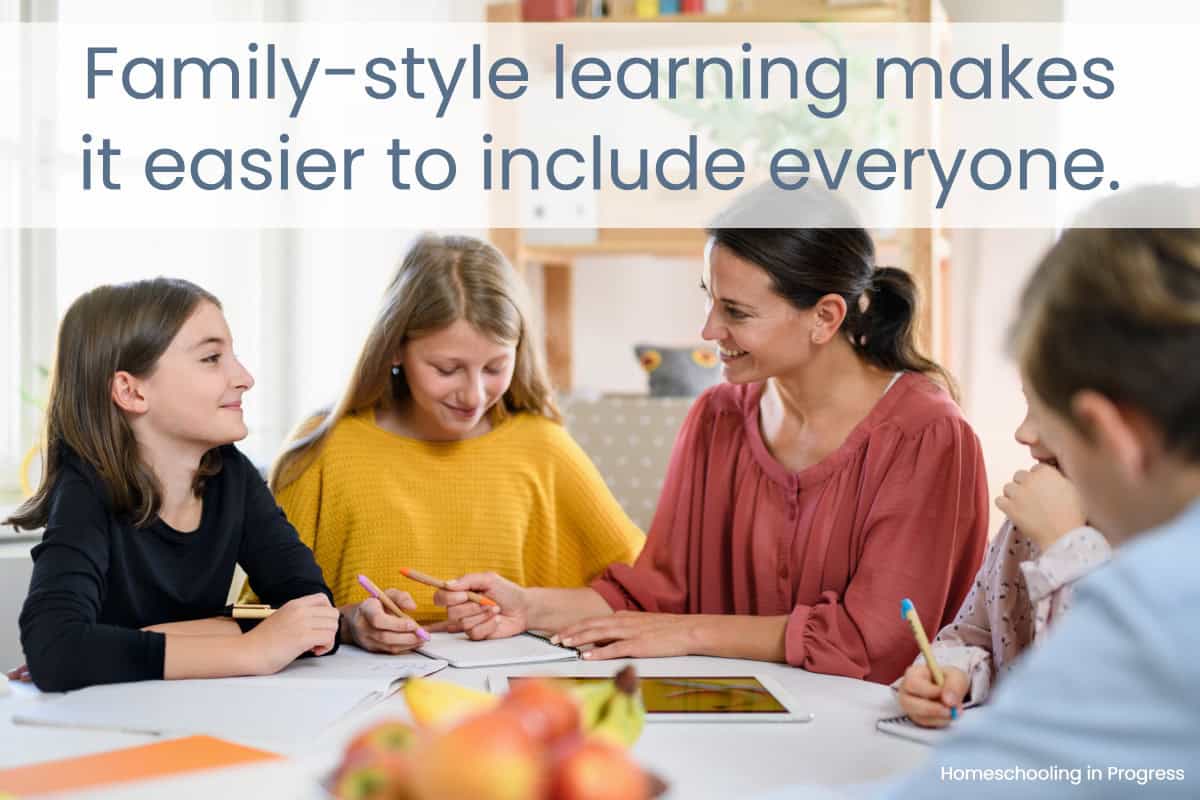Homeschool Tips for Large Families: Finding Peace and Joy in the Chaos
Looking for homeschool tips for large families? Discover 3 practical strategies to help you manage multiple children, simplify your days, and create a peaceful learning environment.

This post may contain affiliate links, which means I may receive a commission, at no extra cost to you, if you make a purchase through a link. Please see my full disclosure for further information.
Some days, homeschooling multiple kids feels like a blessing. Other days, it feels like all you do is move from one need to the next—teaching, comforting, correcting, encouraging—on repeat, with barely a moment to breathe.
If you’re in that place right now, trying to meet the needs of multiple children, all with different personalities, learning styles, and emotional needs… I want you to know: you’re not alone.
This life you’ve chosen—the one where your kitchen table turns into a classroom and your days are full of both math tears and read-aloud giggles—is beautiful, but it’s not easy. And when you’re stretched thin, it’s easy to wonder if you’re doing enough… or if you’re doing it “right.”
Here’s the good news: there is a way to homeschool multiple children with more peace and less pressure. You don’t need a perfect schedule or a background in classroom management—you just need a few simple strategies that bring clarity and calm to your day.
Let’s break it down into three sanity-saving strategies that will help you homeschool smarter, not harder.

3 Sanity-Saving Homeschool Tips for Large Families
There’s a certain beauty to homeschooling a large family—but it doesn’t always feel peaceful, especially when the baby is crying, a toddler is dumping blocks on the floor, and your 10-year-old is asking how to diagram sentences while the soup is boiling over on the stove.
Homeschooling multiple children across different ages and stages can feel overwhelming, but it can be done with peace, purpose, and even joy. It’s not about having a picture-perfect routine. It’s about building a home where learning happens in the midst of real life.
Let’s look at three practical strategies that can help simplify your days and create more breathing room for you and your children.

Strategy 1: Embrace Family-Style Learning
One of the most powerful ways to bring calm to a larger-family homeschool is to teach as many children together as possible.
Subjects like history, science, religion, nature study, read-alouds, art, and even some writing can be learned family-style—with everyone gathered around the table or snuggled on the couch, learning together.
Of course, not everyone will be doing the exact same thing. You can layer the learning by age:
Younger children may draw or dictate their thoughts
Older students can write paragraphs, do extra reading, or explain concepts to siblings
Teens can help lead a discussion or complete an extension project
This not only simplifies your planning, it creates beautiful moments of connection and cooperation—siblings learning side by side, helping each other, laughing over a shared activity.
Try This:
Choose one read-aloud book that everyone can enjoy
Add a simple hands-on activity or nature walk related to the topic
Let each child respond at their own level (drawing, writing, retelling, etc.)
Need a Concrete Example? Here's a Family-Style History Lesson
Imagine you’re learning about the American Revolution.
You start your morning together with a read-aloud chapter from a historical fiction book like Phoebe the Spy or Johnny Tremain.
Afterward, you have a short group discussion: What would it be like to live during that time? What risks did ordinary people take?
Your younger children draw a picture of a colonial home or a tea party protest while you write their narration underneath.
Your older child writes a short paragraph comparing the Boston Tea Party to modern protests.
Everyone works together to make homemade tricorn hats or bake a simple colonial-era recipe as a hands-on activity.
This entire lesson takes about an hour, and everyone learned something—at their own level—while staying connected as a family.
Family-style learning works beautifully in subjects like history, science, and nature study. If you’re looking for gentle, hands-on ways to explore the natural world together, check out our seasonal nature study units.

Strategy 2: Set Up Rhythms, Not Rigid Schedules
If you’ve ever created a detailed hour-by-hour schedule and watched it fall apart by 10 a.m., you’re not alone. Rigid plans rarely hold up in large family life.
Instead, lean into rhythms.
Think of your day in gentle blocks of time:
Morning routine and prayer
Morning basket or group lessons
Independent work time
Lunch and read-aloud
Quiet time or chores
Afternoon free play or projects
These rhythms give structure without stress. Kids learn what to expect, and you gain flexibility to adapt when things don’t go perfectly (because let’s face it—they rarely do).
Start small:
Pick 2 or 3 anchor points in your day (like morning time, lunch, and quiet time)
Build habits around those
Watch how peace begins to settle in
Bonus Tip: Older kids can help build the rhythm and take ownership of their part in it.
“These simple anchors—morning time, work blocks, and quiet time—keep our days steady, even when the details shift.”
An Example of Our Homeschool Routine
Using anchors in our homeschool day helps create a natural, peaceful rhythm. We begin each morning together with prayer, something artistic, or a read-aloud. Our morning basket time used to be much longer when I was homeschooling just my three older kids. Now, with two in high school and only one in elementary, we don’t do as much together—but starting the day side by side is still a favorite part of our routine.
After that, we shift into independent work. My high schoolers prefer to work quietly in their rooms while I sit at the table with my youngest for his lessons. In the afternoon, we break for lunch and quiet time. That’s when my older kids finish up their assignments, my youngest enjoys a little Kindle time, and I get some work done for my business.
Before dinner and evening activities, we come back together to tidy up the house. These simple anchors—morning time, work blocks, and quiet time—keep our days steady, even when the details shift.

Strategy 3: Create Independent Work Stations or "Busy Baskets"
One of the biggest struggles in a large family homeschool is keeping everyone meaningfully occupied—especially while you’re working one-on-one with another child.
Enter: Independent Work Stations or Busy Baskets.
These are simple, low-prep activities that your children can do on their own. Depending on age, these might include:
Puzzles, tangrams, or building toys
Copywork or handwriting pages
Preschool activity trays or sensory bins
Drawing prompts or watercolor paints
Audiobooks or music with headphones
Montessori-style trays for early learners
Educational games or flashcards
Rotate materials weekly to keep them fresh and interesting. You might even assign a specific drawer or basket to each child with their name and age-appropriate materials inside.
The goal isn’t to keep them endlessly entertained—it’s to encourage responsibility, independence, and calm pockets of focus throughout the day.

Click the picture above to download the page.
An Example from Our Homeschool Experience
From the time my youngest was about two years old, he had a dedicated shelf in our learning area. As I created simple activities for him, I’d show him how to use each one and place it on his shelf. He knew he could choose anything from that space to work on during his “school time.” This gave him a sense of independence—and gave me time to focus on teaching my older children.
When he was very little, he started with just one shelf. By the time he reached kindergarten, he had his own three-shelf bookcase filled with hands-on learning activities. Each month, I rotated in new materials: two sensory bins, fresh batches of homemade playdough, building blocks, a math basket with counters and dice, and a variety of seasonal or thematic preschool tasks. He stayed engaged with meaningful work while his siblings and I enjoyed focused, uninterrupted learning time together.

A Final Word of Encouragement
Homeschooling a large family is no small task. It’s messy. It’s loud. And some days feel like you’re barely keeping your head above water.
But peace isn’t the absence of noise—it’s the presence of calm and confidence in the midst of real life.
Take a breath. Start small. Choose one tip to try this week. And remember, what you’re doing matters—more than you know.
You’re building something beautiful, one day at a time.
Want More Support for Homeschool Multiple Kids?
Join our email list for connection, encouragement, and family-style ideas. Plus grab your free First Week of Family-Style Homeschooling Guide
Browse our preschool activities to keep little hands learning while you teach
Feeling stretched too thin in your homeschool? Longing for more peace, connection, and rhythm in your days?
You’re not alone—and I’d love to help.I have a brand-new course just for homeschool moms teaching multiple ages. In Learning Gently, Living Fully, you’ll learn how to create a peaceful family rhythm, teach with confidence, and build a homeschool that nurtures your whole family—without burning out.



